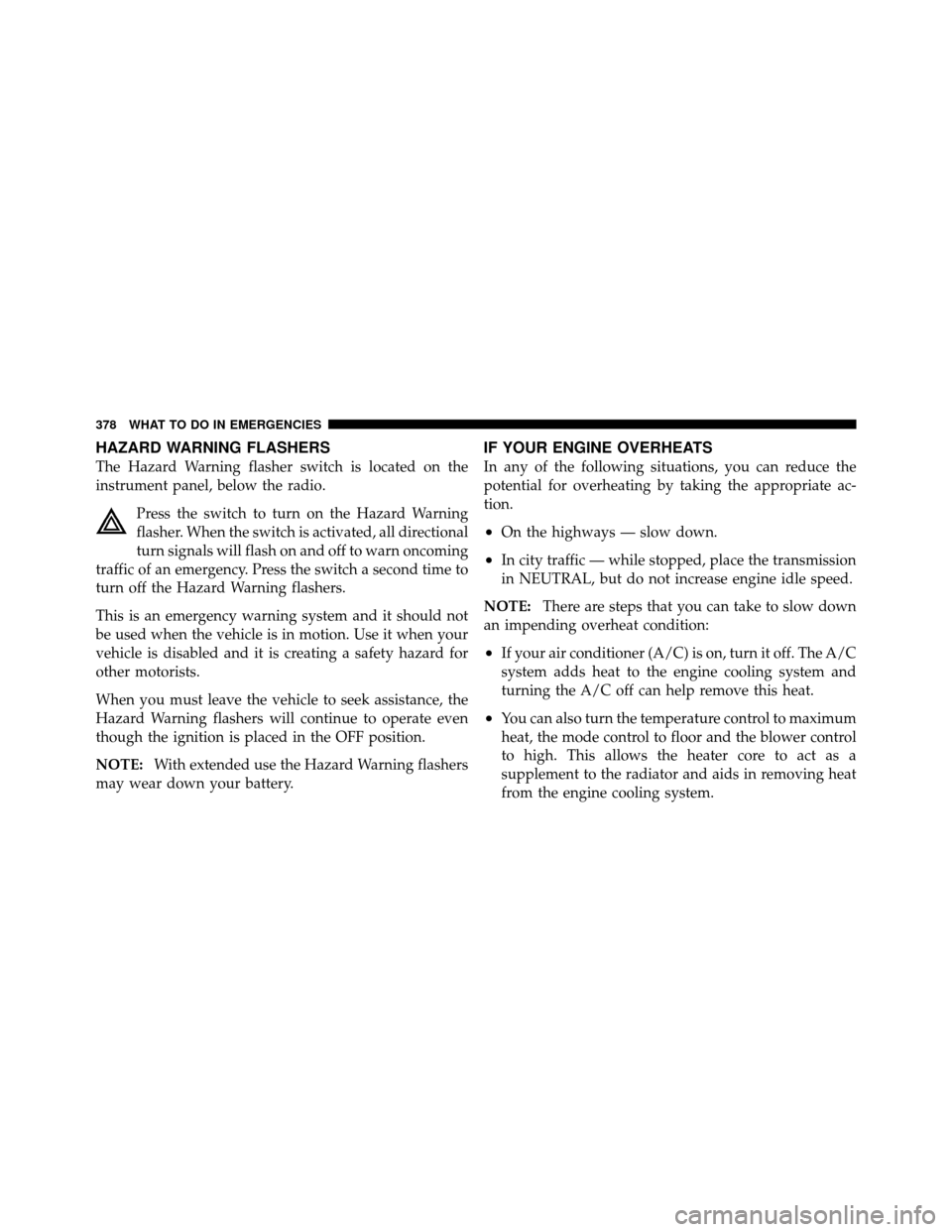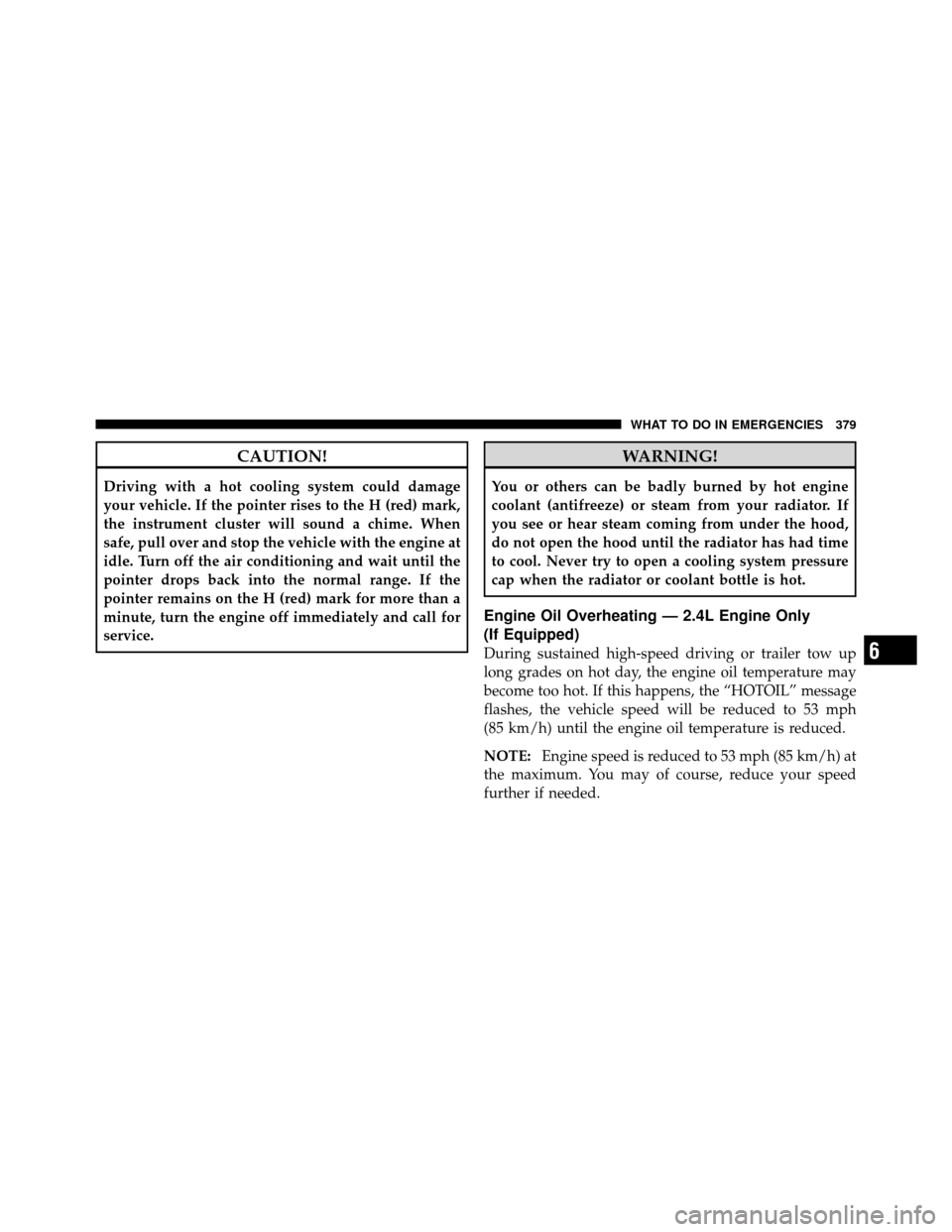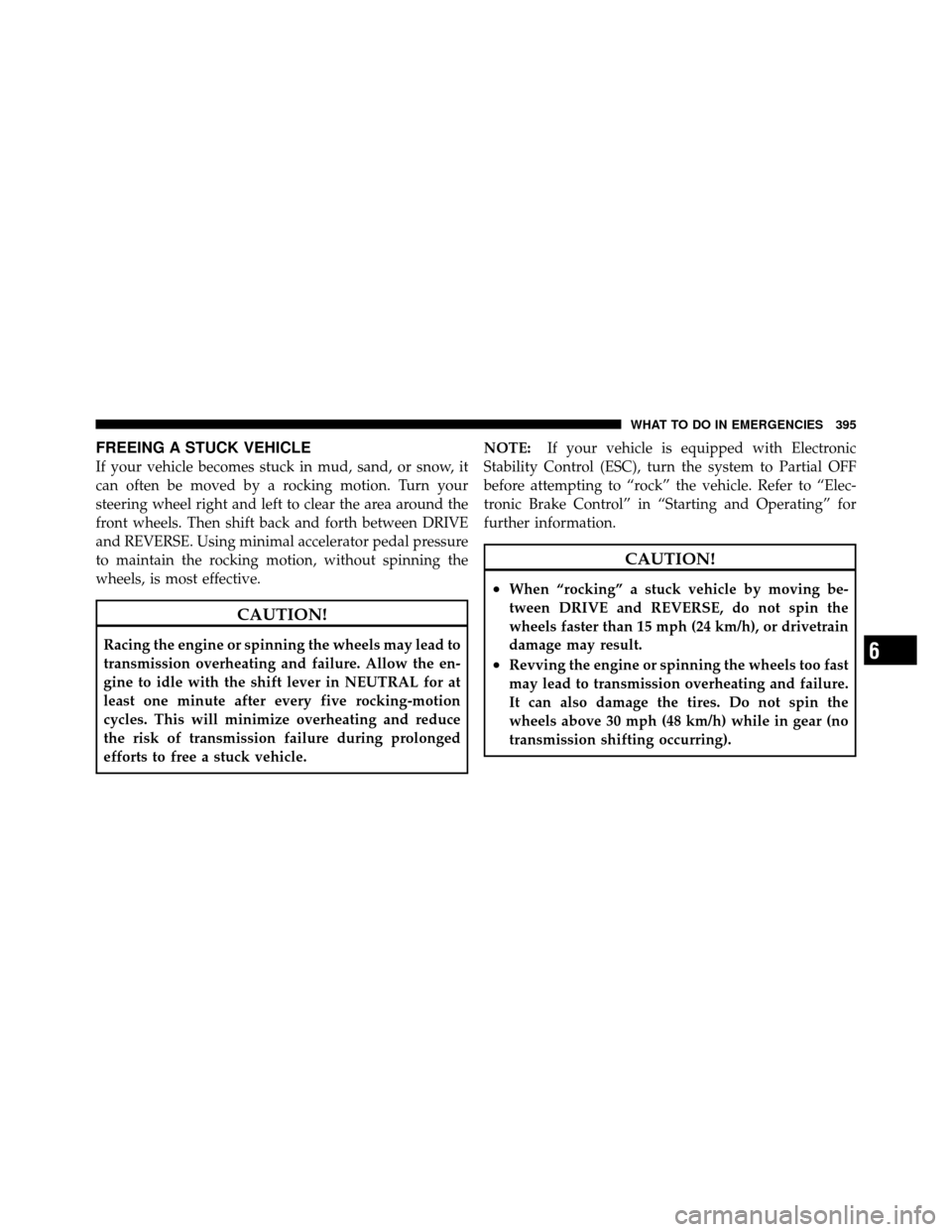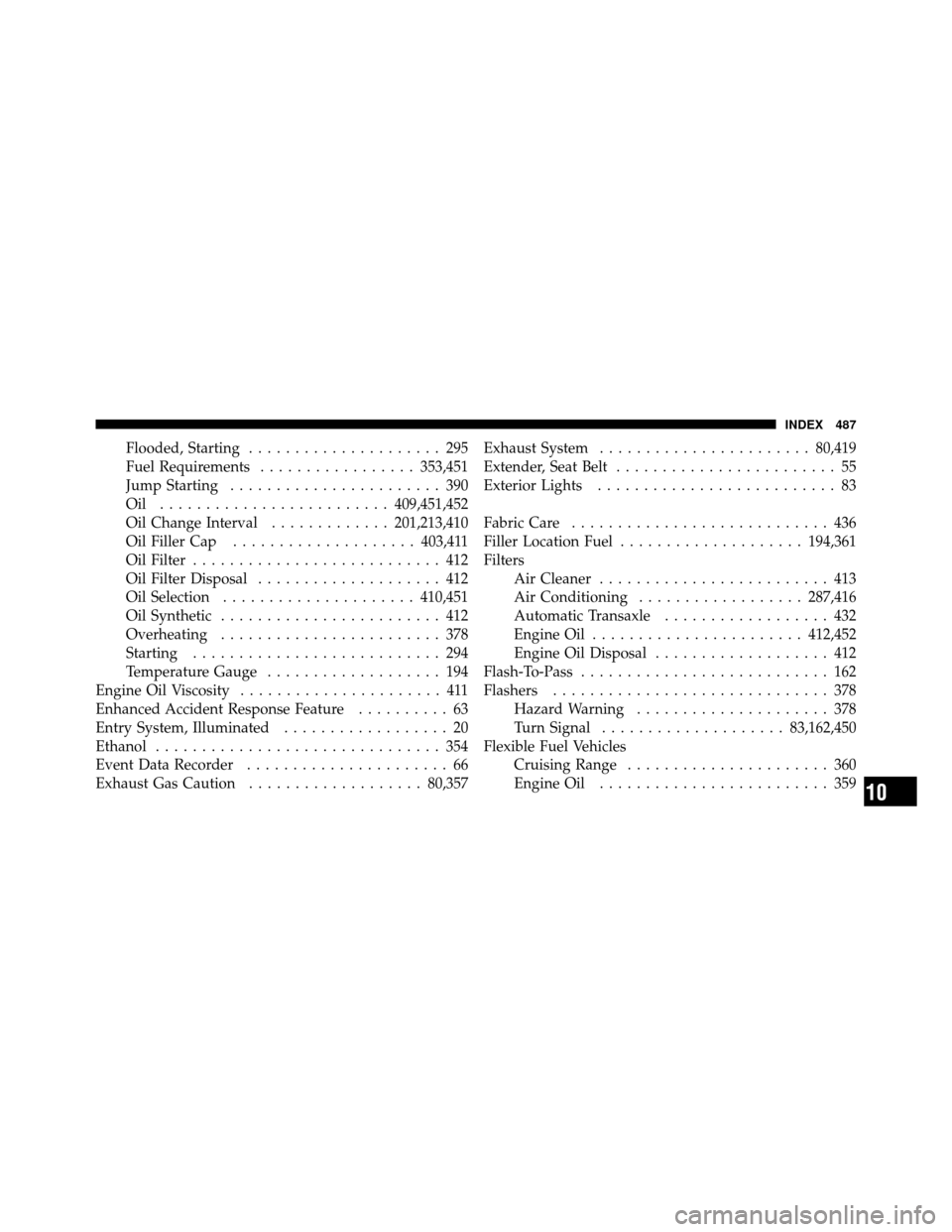Page 378 of 505
•Use speed control in flat terrain and with light loads to
maximize fuel efficiency.
Cooling System
To reduce potential for engine and transmission over-
heating, take the following actions:
•City Driving
When stopped for short periods of time, shift the trans-
mission into NEUTRAL and increase engine idle speed.
•Highway Driving
Reduce speed.
•Air Conditioning
Turn off temporarily.
RECREATIONAL TOWING
(BEHIND MOTORHOME, ETC.)
Towing This Vehicle Behind Another Vehicle
Recreational towing is not allowed.
CAUTION!
DO NOT flat tow this vehicle. Damage to the drive-
train will result.
NOTE:
This vehicle may be towed on a flatbed or vehicle
trailer provided all four wheels are OFF the ground.
CAUTION!
Towing this vehicle in violation of the above require-
ments can cause severe transmission damage. Dam-
age from improper towing is not covered under the
New Vehicle Limited Warranty.
376 STARTING AND OPERATING
Page 379 of 505
WHAT TO DO IN EMERGENCIES
CONTENTS
�Hazard Warning Flashers ................ 378
� If Your Engine Overheats ................ 378
▫ Engine Oil Overheating — 2.4L Engine Only
(If Equipped) ....................... 379
� Jacking And Tire Changing ............... 380
▫ Jack Location ....................... 380
▫ Spare Tire Stowage ................... 380
▫ Preparations For Jacking ............... 381
▫ Jacking Instructions ................... 382 ▫
Road Tire Installation ................. 388
� Jump-Starting ........................ 390
▫ Preparations For Jump-Start ............. 391
▫ Jump-Starting Procedure ............... 393
� Freeing A Stuck Vehicle ................. 395
� Shift Lever Override ................... 396
� Towing A Disabled Vehicle ............... 397
▫ Without The Ignition Key .............. 399
6
Page 380 of 505

HAZARD WARNING FLASHERS
The Hazard Warning flasher switch is located on the
instrument panel, below the radio.Press the switch to turn on the Hazard Warning
flasher. When the switch is activated, all directional
turn signals will flash on and off to warn oncoming
traffic of an emergency. Press the switch a second time to
turn off the Hazard Warning flashers.
This is an emergency warning system and it should not
be used when the vehicle is in motion. Use it when your
vehicle is disabled and it is creating a safety hazard for
other motorists.
When you must leave the vehicle to seek assistance, the
Hazard Warning flashers will continue to operate even
though the ignition is placed in the OFF position.
NOTE: With extended use the Hazard Warning flashers
may wear down your battery.
IF YOUR ENGINE OVERHEATS
In any of the following situations, you can reduce the
potential for overheating by taking the appropriate ac-
tion.
•On the highways — slow down.
•In city traffic — while stopped, place the transmission
in NEUTRAL, but do not increase engine idle speed.
NOTE: There are steps that you can take to slow down
an impending overheat condition:
•If your air conditioner (A/C) is on, turn it off. The A/C
system adds heat to the engine cooling system and
turning the A/C off can help remove this heat.
•You can also turn the temperature control to maximum
heat, the mode control to floor and the blower control
to high. This allows the heater core to act as a
supplement to the radiator and aids in removing heat
from the engine cooling system.
378 WHAT TO DO IN EMERGENCIES
Page 381 of 505

CAUTION!
Driving with a hot cooling system could damage
your vehicle. If the pointer rises to the H (red) mark,
the instrument cluster will sound a chime. When
safe, pull over and stop the vehicle with the engine at
idle. Turn off the air conditioning and wait until the
pointer drops back into the normal range. If the
pointer remains on the H (red) mark for more than a
minute, turn the engine off immediately and call for
service.
WARNING!
You or others can be badly burned by hot engine
coolant (antifreeze) or steam from your radiator. If
you see or hear steam coming from under the hood,
do not open the hood until the radiator has had time
to cool. Never try to open a cooling system pressure
cap when the radiator or coolant bottle is hot.
Engine Oil Overheating — 2.4L Engine Only
(If Equipped)
During sustained high-speed driving or trailer tow up
long grades on hot day, the engine oil temperature may
become too hot. If this happens, the “HOTOIL” message
flashes, the vehicle speed will be reduced to 53 mph
(85 km/h) until the engine oil temperature is reduced.
NOTE:Engine speed is reduced to 53 mph (85 km/h) at
the maximum. You may of course, reduce your speed
further if needed.6
WHAT TO DO IN EMERGENCIES 379
Page 397 of 505

FREEING A STUCK VEHICLE
If your vehicle becomes stuck in mud, sand, or snow, it
can often be moved by a rocking motion. Turn your
steering wheel right and left to clear the area around the
front wheels. Then shift back and forth between DRIVE
and REVERSE. Using minimal accelerator pedal pressure
to maintain the rocking motion, without spinning the
wheels, is most effective.
CAUTION!
Racing the engine or spinning the wheels may lead to
transmission overheating and failure. Allow the en-
gine to idle with the shift lever in NEUTRAL for at
least one minute after every five rocking-motion
cycles. This will minimize overheating and reduce
the risk of transmission failure during prolonged
efforts to free a stuck vehicle.NOTE:
If your vehicle is equipped with Electronic
Stability Control (ESC), turn the system to Partial OFF
before attempting to “rock” the vehicle. Refer to “Elec-
tronic Brake Control” in “Starting and Operating” for
further information.
CAUTION!
•When “rocking” a stuck vehicle by moving be-
tween DRIVE and REVERSE, do not spin the
wheels faster than 15 mph (24 km/h), or drivetrain
damage may result.
•Revving the engine or spinning the wheels too fast
may lead to transmission overheating and failure.
It can also damage the tires. Do not spin the
wheels above 30 mph (48 km/h) while in gear (no
transmission shifting occurring).6
WHAT TO DO IN EMERGENCIES 395
Page 423 of 505

Under normal operating conditions, the catalytic con-
verter will not require maintenance. However, it is im-
portant to keep the engine properly tuned to assure
proper catalyst operation and prevent possible catalyst
damage.
NOTE:Intentional tampering with emissions control
systems can result in civil penalties being assessed
against you.
In unusual situations involving grossly malfunctioning
engine operation, a scorching odor may suggest severe
and abnormal catalyst overheating. If this occurs, stop
the vehicle, turn off the engine and allow it to cool.
Service, including a tune-up to manufacturer’s specifica-
tions, should be obtained immediately. To minimize the possibility of catalytic converter dam-
age:
•Do not shut off the engine or interrupt the ignition,
when the transmission is in gear and the vehicle is in
motion.
•Do not try to start the engine by pushing or towing the
vehicle.
•Do not idle the engine with any spark plug wires
disconnected or removed, such as when diagnostic
testing, or for prolonged periods during very rough
idle or malfunctioning operating conditions.
7
MAINTAINING YOUR VEHICLE 421
Page 488 of 505

DisposalAntifreeze (Engine Coolant) ............. 425
Engine Oil ......................... 412
Door Locks ............................. 30
Door Locks, Automatic .................... 32
Door Opener, Garage ..................... 172
Driver’s Seat Back Tilt .................... 151
Driving On Slippery Surfaces .................. 306
Through Flowing, Rising, or Shallow
Standing Water ...................... 307
E-85 Fuel ............................. 357
Electric Rear Window Defrost ............... 188
Electric Remote Mirrors ................... 109
Electrical Power Outlets ................... 178
Electronic Speed Control (Cruise Control) ...... 169
Electronic Stability Control (ESC) ............. 319
Electronic Vehicle Information Center (EVIC) .... 210Emergency Deck Lid Release
................ 38
Emergency Trunk Release ................... 38
Emergency, In Case of Jacking ............................ 380
Jump Starting ....................... 390
Overheating ........................ 378
Towing ............................ 397
Emission Control System Maintenance ......... 406
Engine ............................... 403
Air Cleaner ......................... 413
Block Heater ........................ 297
Break-In Recommendations .............. 78
Checking Oil Level ................... 409
Compartment ....................... 404
Compartment Identification ............. 404
Coolant (Antifreeze) ................ 422,452
Cooling ........................... 422
Exhaust Gas Caution ................80,357
Fails to Start ........................ 295
486 INDEX
Page 489 of 505

Flooded, Starting..................... 295
Fuel Requirements ................. 353,451
Jump Starting ....................... 390
Oil ......................... 409,451,452
Oil Change Interval .............201,213,410
Oil Filler Cap .................... 403,411
Oil Filter ........................... 412
Oil Filter Disposal .................... 412
Oil Selection ..................... 410,451
Oil Synthetic ........................ 412
Overheating ........................ 378
Starting ........................... 294
Temperature Gauge ................... 194
Engine Oil Viscosity ...................... 411
Enhanced Accident Response Feature .......... 63
Entry System, Illuminated .................. 20
Ethanol ............................... 354
Event Data Recorder ...................... 66
Exhaust Gas Caution ................... 80,357Exhaust System
....................... 80,419
Extender, Seat Belt ........................ 55
Exterior Lights .......................... 83
Fabric Care ............................ 436
Filler Location Fuel .................... 194,361
Filters Air Cleaner ......................... 413
Air Conditioning .................. 287,416
Automatic Transaxle .................. 432
Engine Oil ....................... 412,452
Engine Oil Disposal ................... 412
Flash-To-Pass ........................... 162
Flashers .............................. 378
Hazard Warning ..................... 378
Turn Signal .................... 83,162,450
Flexible Fuel Vehicles Cruising Range ...................... 360
Engine Oil ......................... 359
10
INDEX 487